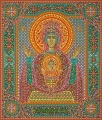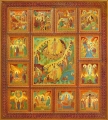|

The Virgin
|
|
Image of Our Lady “I am with you and no one against you”
|
| Literally it means “I am always with you, and no one can harm you”. The very name of the miraculous image fills our heart with piety and hope: God is with us, and Our Lady’s mercy always covers us. In the most desperate life situations we are not alone, even if it is unseen by eyes. But divine presence is in the heart of every human being. Grace and divine help cannot flow into closed souls, only when we appeal to the High with awe in our hearts the Savior reaches out to us with consolation and help. |
| |
| |
|
|
|
|
ALL The Virgin |
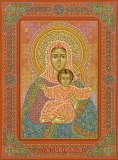
|
|
Image of Our Lady “I am with you and no one against you”
Literally it means “I am always with you, and no one can harm you”. The very name of the miraculous image fills our heart with piety and hope: God is with us, and Our Lady’s mercy always covers us. In the most desperate life situations we are not alone, even if it is unseen by eyes. But divine presence is in the heart of every human being. Grace and divine help cannot flow into closed souls, only when we appeal to the High with awe in our hearts the Savior reaches out to us with consolation and help.
|
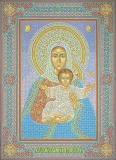
|
|
Image of Our Lady “I am with you and no one against you”
Literally it means “I am always with you, and no one can harm you”. The very name of the miraculous image fills our heart with piety and hope: God is with us, and Our Lady’s mercy always covers us. In the most desperate life situations we are not alone, even if it is unseen by eyes. But divine presence is in the heart of every human being. Grace and divine help cannot flow into closed souls, only when we appeal to the High with awe in our hearts the Savior reaches out to us with consolation and help.
|
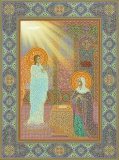
|
|
The Annunciation
The icon “The Annunciation” by Yuriy Kuznetsov was painted according to the ancient monastery traditions, it is well preserved. The icon was exhibited at the expositions, devoted to the Spiritual Renaissance of the modern art.
Before the icon “The Annunciation” you pray Our Lady for relief and recovery from ailments and liberation from restraint.
|

|
|
Image of Our Lady “Blessed Heaven”
Image of Our Lady “Blessed Heaven” has always been esteemed in Moscow; it had been and still is in the Archangelsk Cathedral of the Moscow Kremlin. Our Lady is in full length, She has the Infant Christ in her left hand. Some people name this image of Virgin “What To Name You?” by the prayer’s text. Replicas of the “Blessed Heaven” can be found in many churches and monasteries of Russia. Before the icon “The Annunciation” you pray for recovery from mental and physical diseases, for those, who live vicious life, for set in the paths of righteousness, and before traveling by air.
|

|
|
Image of Our Lady “The Joyful”
Image of Our Lady “The Joyful” is one of the most revered among the Russian people. This icon represents the fullness of Motherhood, so in the Orthodox Church it was in custom before childbirth to say the prayer with akathists to the Holy Mother in honor of Her images “The Joyful” and “Helper In Labor”. Pregnancy and forthcoming labors are events, that shows divine greatness of life, so in the ancient Russia pregnant women had special prayers for the period. Also women who want to have children, pray before this icon.
|
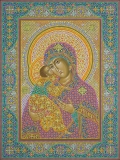
|
|
Theotokos of Vladimir
The icon is worshipped as wonderworking. According to the church tradition, the icon was painted by Evangelist Luca on the board, which was the part of the table, where Jesus with Mary and Joseph had meals. The icon was painted during the mortal life of the Holy Virgin and presented to her by the Holy Painter. Seeing Her image on the icon the Holy Virgin Mary said: “The Grace of Born from Me and Mine will be with this Icon”. And this Grace to Words of Our Lady is always there, where the icon Our Lady of Vladimir is, revealing in countless wonders. People pray to the Holy Virgin before this icon in hard times, during enemy invasions, ask for people unity, for success in feat of arms, for protection from enemies.
|
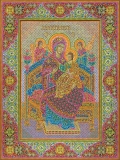
|
|
Image of Our Lady Pantagia Pantanassa “The Most-Holy Queen of All”
This icon was painted in the seventeenth century and from that time it has been in the holy and great Monastery of Vatopedi, Mount Athos, Greece. Its miraculous powers revealed when a young man came up to it and at that moment all saw a glowing light radiating from the face of the Theotokos and an invisible power pushed the young man down to the ground. Then the young man confessed that he did not believe and was a participant in the black arts. He changed his life and became an Orthodox Christian. Pantanassa is the Most-Holy Queen of All. Apart from healing from evil sorcery it has the grace to heal people with cancer. So in 1995 the replica was brought to the Moscow Children Cancer Center. At the moment the icon is in the Moscow All-Saints Cathedral.
|
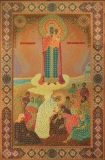
|
|
Image of Our Lady Theotokos, the Joy of All Who Sorrow
This type of icons came to Russia soon after Russia was baptized. Apart from Theotokos, depicted before Christ or alone, there are people in sorrow supplying for Her intercession, and angels, performing good deeds in the name of the Holy Virgin. Before this icon people pray when they are in sorrow, in desperation, when seeking for protection and consolation, when they have incurable illnesses. It is patroness of all suffering and oppressed, orphans and miserable. The icon is well-known for its wonders; not only poor people pray to it, but also the aristocracy. Even non-orthodox people appeal to it.
|
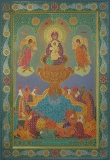
|
|
Panagia The Life Giving Spring
Continuing Greek traditions, in old Russia there was a tradition to sanctify springs, located near churches, dedicate them to the Holy Mother, and paint icons to Our Lady under the name The Life Giving Spring. Springs presented Holy Virgin’s help and God’s grace. The Virgin Mary with her child standing within a stone chalice that presumably represents the living water. At the living water there are people suffering from different diseases, passions and mental illnesses. All of them drink the water and receives cure. There are two meanings in the icon: universal intercession of the Holy Mother and birth of the Savior, who gives a chance of eternal life to everyone.
|

|
|
Our Lady of Iver
Icon of Our Lady of Iver is one of the Athos’ relic. According to the legend, at the iconoclastic period the icon of the Holy Mother, which belonged to a pious widow, was subjected to destruction. At night the widow with her son brought the icon to the sea to set it swimming and thus save it from abuse. Afterwards the widow’s son became an coenobite of the Iver Cloister and told the Athos hermits about his mother’s icon. After almost one hundred years, in 980, monks found the image of the Holy Virgin. It was the very icon of the widow, as at the right cheek of Holy Virgin Mary there was a scar from the iconoclast’s sword. Before this icon those, who are suffering from illnesses and spiritual wounds, pray
|
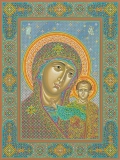
|
|
Our Lady of Kazan
People pray before this icon for recovery of sight and when they have eye illnesses. Also it helps against enemy’s invasions, violence from infidels, and people pray before it for deliverance from the civil wars. It is this icon, that the bride and bridegroom are blessed for the wedding; this icon is in children’s rooms. To the Holy Mother people turn their prayers when they have trouble, disease and misfortune:: “When sorrow and pain visit us, when patience and love fail us, we hasten to Thine Image and pouring forth our tears before Thee, we cry out from the depths of our hearts: Stretch out Thy God-bearing hands, speak unto us words of wisdom, lead us up out of evil” (Akathist to Our Most Holy Lady, K. 4)
|

|
|
Our Lady of Kazan
People pray before this icon for recovery of sight and when they have eye illnesses. Also it helps against enemy’s invasions, violence from infidels, and people pray before it for deliverance from the civil wars. It is this icon, that the bride and bridegroom are blessed for the wedding; this icon is in children’s rooms. To the Holy Mother people turn their prayers when they have trouble, disease and misfortune:: “When sorrow and pain visit us, when patience and love fail us, we hasten to Thine Image and pouring forth our tears before Thee, we cry out from the depths of our hearts: Stretch out Thy God-bearing hands, speak unto us words of wisdom, lead us up out of evil” (Akathist to Our Most Holy Lady, K. 4)
|
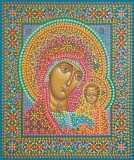
|
|
Our Lady of Kazan
People pray before this icon for recovery of sight and when they have eye illnesses. Also it helps against enemy’s invasions, violence from infidels, and people pray before it for deliverance from the civil wars. It is this icon, that the bride and bridegroom are blessed for the wedding; this icon is in children’s rooms. To the Holy Mother people turn their prayers when they have trouble, disease and misfortune:: “When sorrow and pain visit us, when patience and love fail us, we hasten to Thine Image and pouring forth our tears before Thee, we cry out from the depths of our hearts: Stretch out Thy God-bearing hands, speak unto us words of wisdom, lead us up out of evil” (Akathist to Our Most Holy Lady, K. 4)
|

|
|
Our Lady of Kazan
People pray before this icon for recovery of sight and when they have eye illnesses. Also it helps against enemy’s invasions, violence from infidels, and people pray before it for deliverance from the civil wars. It is this icon, that the bride and bridegroom are blessed for the wedding; this icon is in children’s rooms. To the Holy Mother people turn their prayers when they have trouble, disease and misfortune:: “When sorrow and pain visit us, when patience and love fail us, we hasten to Thine Image and pouring forth our tears before Thee, we cry out from the depths of our hearts: Stretch out Thy God-bearing hands, speak unto us words of wisdom, lead us up out of evil” (Akathist to Our Most Holy Lady, K. 4)
|
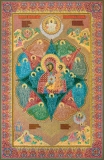
|
|
Panagia of the Unburnt Bush Icon
The icon is based on the miracle witnessed by Moses in the Old Testament. In the book of Exodus, God calls Moses on Mt. Horeb from the midst of a bush which "was burning, yet it was not consumed" (3:2). The Church sees the Unburnt Bush on Horeb as a type of the Most Holy Theotokos, who gave birth to Christ while still remaining a virgin; it is also symbolize the Holy Mother, born in the sinful world, bur remained innocent. The Mother of God, through her Icon of the Unburnt Bush, is regarded as the protector of homes from fire, lightning, as well as thieves and other malefactors. From ancient times it is the patroness of Russian firefighters.
|
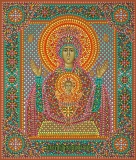
|
|
Inexhaustible Chalice Icon of the Theotokos
Inexhaustible Chalice Icon of the Theotokos - an icon of the Theotokos that became famous in 1878 when it appeared in the Serpukhov Vladichny Vvedensky Convent (Convent of the Entry of the Most Holy Virgin into the Temple). It is honored as miraculous in the Russian Church. The Chalice with the blessing Infant God is an inexhaustible Chalice of Holy Communion that never runs out. It is a symbol of the infinity of heavenly help to the people who approach it with a true faith. The miraculous Inexhaustible Chalice Icon of the Theotokos is known for its healing of those who suffer from drug addiction, alcoholism and smoking, resolving their housing problems.
|

|
|
Icon of the Mother of God "The Unexpected Joy"
The ground for the icon is in the story by Dimitry Rostovsky about the sinful youth, who was praying one day before the icon of the All-Pure Virgin before going out to commit a sin. Suddenly, he saw that wounds appeared on the Lord's hands, feet, and side, and blood flowed from them. The Mother of God told, "You and other sinners because of your sins, crucify Christ anew." Shocked with the vision for a long time he prayed with tears to the All-Pure Mother of God and the Savior for mercy. Finally, he received the unexpected joy of the forgiveness of his sins. Thus he grew in his spirit and totally changed his life.
|
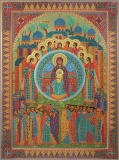
|
|
Icon of the Mother of God "O All-Hymned Mother"
The Icon "O All-Hymned Mother" derives its title from the words of the reverend Ioann Damaskin: "O All-Hymned Mother who bore the Word, holiest of all the saints…." Image of the Holy Mother on this icon has a universe meaning as a joy for all on the Earth and the Heaven. This is an image of the universal church, spiritual and united by love, it is an image of the mother’s loving heart, which gathers the Universe around it. Before the icon "O All-Hymned Mother" people thank the Holy Virgin for all benefits.
|

|
|
Our Lady of Pimen
Icon of the Pimen Holy Mother was brought to Moscow from Constantinople by Pimen Metropolitan in 1381 (1388). The icon received its title after his name. The image is famous for being myrrh-streaming; when invalids were anointed with this myrrh, many of them cured. Our Lady of Pimen were brought out not only to the processions, but also to different houses to perform thanksgiving and communion services for sick people. The image of Our Lady of Pimen is the main altar-piece icon of the Annunciation Cathedral in the Moscow Kremlin.
|
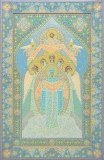
|
|
Icon of the Mother of God of Pskov "the Protection"
The Feast of the Most Holy Mother Protection was established in memory of the miraculous theophany of the Holy Mother in Vlahern Cathedral during Constantinople siege in 910. The Most Holy Mother Protection is a sign of God’s grace, protecting and covering us. The procession to the Heaven, to the Savior is depicted on the icon. The procession is headed by the Holy Virgin, who carries a blanket in her hands, and saints follow Her. The icon symbolizes prayer of the whole Heaven Church for the human being.
|
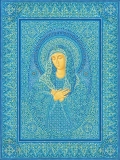
|
|
Icon of the Mother of God "of Tenderness"
The Seraphim-Diveyevo "Tenderness" Icon of the Mother of God belonged to St Seraphim of Sarov, and was his cell icon. According to the legend, with the oil from the lampion, which burned before this holy icon, the saint anointed the sick, and prayed before the icon, and the sick received healing after the anointing. The Seraphim-Diveyevo "Tenderness" Icon has words of the ancient Akathist to the Holy Mother. People pray the Holy Virgin before the Seraphim-Diveyevo "Tenderness" Icon for curing and salvation.
|

|
|
Our Lady of Smolensk (Hodigitria)
The miraculous icon of the Most Holy Virgin Hodigitria Smolenskaya is well-known in Russia from the ancient times. Hodigitria is the Greek word for Guiding Lady. There are several version about the title, but the absolute truth is that Holy Virgin is the Guidance Lady for all Christians around the world on their way to salvation. Our Lady of Smolensk helps all praying in curing from incurable diseases, in search of family peace and in other difficult and irresolvable situations, as She is our first Intercessor with God.
|
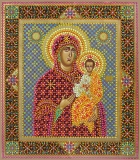
|
|
Our Lady of Smolensk (Hodigitria)
The miraculous icon of the Most Holy Virgin Hodigitria Smolenskaya is well-known in Russia from the ancient times. Hodigitria is the Greek word for Guiding Lady. There are several version about the title, but the absolute truth is that Holy Virgin is the Guidance Lady for all Christians around the world on their way to salvation. Our Lady of Smolensk helps all praying in curing from incurable diseases, in search of family peace and in other difficult and irresolvable situations, as She is our first Intercessor with God.
|
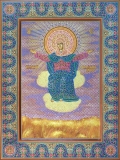
|
|
Icon of the Mother of God the Multiplier of Wheat
The Icon of the Mother of God, the "Multiplier of Wheat", was painted at the blessing of the Elder Ambrose of the Visitation Optina wilderness monastery. On this icon, rather unusual, the Mother of God is depicted sitting upon the clouds, and Her hands are extended in blessing. Beneath her is a compressed field, and on it amidst the grass and flowers stand and lay sheaves of rye. Ambrose called the icon "Multiplier of Wheat", indicating by this, that the Most Holy Theotokos "is a Helper for people in their labors for the acquiring of their daily bread." People pray before the icon for the daily bread, hog and hominy, blessing for daily works, protection of seeds, fertility. Prayer to the Holy Mother before Her icon the "Multiplier of Wheat” helps in the grip of poverty and daily life.
|
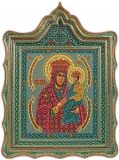
|
|
Icon of the Mother of God "the Surety of Sinners"
The Icon of the Mother of God "Surety of Sinners" is known by this name because of the inscription on the icon: "I am the Surety of sinners for My Son Who has entrusted Me to hear them, and those who bring Me the joy of hearing them will receive eternal joy through Me." The icon was glorified during a cholera epidemic, when many people fell deathly ill, and were restored to health after praying before the icon. The "Surety of Sinners" means Guarantee for the sinners before Christ. The title of the icon shows infinite love of Holy Mother to the sinful human beings, the love, which She always showed. Believers began to flock to it to pray for the healing of their sorrows and sicknesses, for salvation of sinners.
|
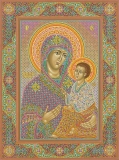
|
|
The Theotokos of Tikhvin
People pray before the Holy Theotokos of Tikhvin icon for giving sight to the blind and healing ocular diseases, when their children are sick, their joints are weakened; for healing palsy; during the enemy invasion; for protection against unorthodox violence and internal conflicts. The Icon of the Holy Theotokos of Tikhvin is considered a patron of infants.
The Icon of the Holy Theotokos of Tikhvin is one of the eight miraculous and most honored icons of the Theotokos in Russia.
|

|
|
The Icon of the Three-handed Theotokos
The history of the Icon of the Three-handed Theotokos is closely connected with the life of John of Damascus who put a lot of efforts into defending icons during the time of the iconoclasm. In order to get rid of such a dangerous defender he was belied and as a sign of punishment for alleged treason he was subjected to cutting off of his right hand. For the whole night John of Damascus fervently prayed before the icon of the Theotokos for the healing of his hand with which he had ardently defended holy icons in his letters. His plea was heard and his hand healed. As a token of gratitude he attached a silver right hand to the icon of the Theotokos before which he had been praying. The icon is known for its miraculous healings.
|
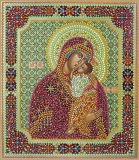
|
|
Our Lady of “Tenderness”
The icon of the Holy Mother Galich-Chukhlomskaya “Tenderness” was found by the great hermit of the Kostroma Area Avraamiy Gorodetskiy, the Chukhloma wondermaker, in 1350 by the city of Galich. The reverend Avraamiy worshipped the Holy Virgin with special love and piety. According to the Live of Saint, the wonderworking image appeared on a tree on one of the hills at the shore of a lake in the wild, after prayer of the Reverend, when he asked blessing for the endeavor. At the place of the miraculous appearance of icon the reverend Avraamiy founded a cloister. Before the icon “Tenderness” people pray the Holy Mother for the cure from serious illness.
|
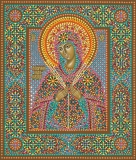
|
|
The Softener of Evil Hearts (Seven-Arrowed)
Praising the Infant Savior whom Mary and Joseph brought to the temple old Simeon prophesied about the Theotokos’ suffering, “…yea and a sword shall pierce through thine own soul; that thoughts out of many hearts may be revealed.” (Luke 2:34-35). This prophecy by Simeon is portrayed by visible symbols – seven swords (or arrows): three on the right side, three – on the left and one below. Number seven means the fullness of grief, sadness and heart pain that the Theotokos suffered in her earthly life. People pray before this icon for pacifying the warring, for softening of evil hearts; it is addressed to with a plea to soften every evil, jealousy, hatred; people get comfort when in grief and pain of the heart, they get comfort in suffering and pray for healing from cholera, lameness and laxation.
|
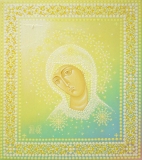
|
|
Theophany of the Holy Mother
From the very first ages of Christianity and to our times in many countries people witness theophany of the Holy Mother. A lot of books, icons, monasteries, memorable marks are devoted to this. In the memory of theophanies the Orthodox Church performs processions with icons; disseminates literature about theophanies; composes special prayers. Theophanies and revelations of the Holy Virgin were experienced both by hermits and commoners, in reality and in dreams. The icon painter Yuriy Kuznetsov depicted these wonderful events in the series of his icons under the name “Theophany”.
|

|
|
The Multi-Image Icon
Images of different topics are gathered together on this icon, therefore it is called multi-image. Different events from the lives of the Savior Jesus Christ and the Most Holy Theotokos as well as the themes of great Church festivals are portrayed here. We can see on this icon – the Resurrection of Christ, Descent into hell, Erection of the True Cross of the Lord, Ascension of Christ, Christ’s Entry to Jerusalem, Transfiguration, Baptism of Christ, Holy Trinity, Presentation, Dormition of the Holy Theotokos, Annunciation, Introduction of the Theotokos to the Temple, Christmas, Birth of the Theotokos.
|
| To go back into beginning |
|
|
|

